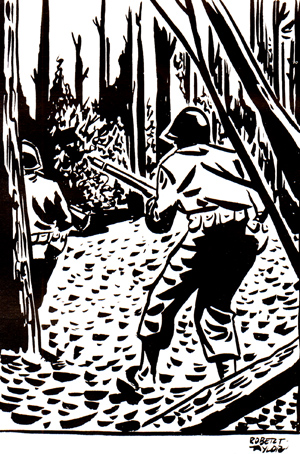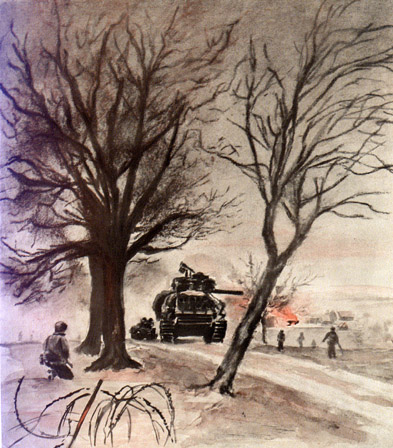14th Armored Division
Combat History
The 14th Armored Division landed at Marseilles, France, 29 October 1944. On 12 November, Headquarters, Combat Command R was ordered to Nice. The 19th and 68th Armored Infantry Battalions were attached to CCR.
The 19th AIB moved to the area of Nice on the 13th, with the 68th AIB following the next day. The two battalions were the first elements of the Division to enter combat, maintaining defensive positions
in the Maritime Alps along the Franco-Italian frontier. Meanwhile the rest of the Division moved north to the area of Epinal. On 19 November, CCA joined Seventh Army's VI Corps in its drive through the
Vosges Mountains. Hard fighting in and around the mountain towns of Gertwiller, Benfeld, and Barr cracked Nazi defenses, and the Division was on the Alsatian Plain early in December.
Rivera to the Rhine PDF
Rivera to the Rhine PDF

The Division began assembling at Hochfelden on the Alsatian Plain to the east of Strasbourg on 1 December. By 11 December advance elements of the Division began movement across the Moder River into the
Haguenau woods in preparation for an offensive to clear the Alsace of German forces. The Division began its attacks on 13 December and reached the German border along the Lauter River two days later.
Led by troops the 19th AIB, the Division crossed the river into Germany in the area of Wissembourg. On the 17th they began to attack the Siegfried Line in force. Despite making good progress in
breaching the German defensive line, the Division was ordered to withdraw into the Alsace on 19 December due to the major German offensive in the Ardennes.
On Christmas Day TaskForce Hudelson, a relatively small force without tank support, was formed around the Division's 62nd AIB and 94th Cavalry Squadron. The TF was assigned defensive positions in the
mountainous area running south of Bitche in the area of Bannstein. On New Year's Eve, TF Hudelson received the first attacks of Operation Nordwind, the last major German offensive of the war.
Engaged by elements of five German divisions the TF managed to delay the enemy advance long enough for strong reinforcements to arrive and contain the thrust.

The Division began assembling at Hochfelden on the Alsatian Plain to the east of Strasbourg on 1 December. By 11 December advance elements of the Division began movement across the Moder River into the
Haguenau woods in preparation for an offensive to clear the Alsace of German forces. The Division began its attacks on 13 December and reached the German border along the Lauter River two days later.
Led by troops the 19th AIB, the Division crossed the river into Germany in the area of Wissembourg. On the 17th they began to attack the Siegfried Line in force. Despite making good progress in
breaching the German defensive line, the Division was ordered to withdraw into the Alsace on 19 December due to the major German offensive in the Ardennes.
The division's 11 day stand at Hatten-Rittershoffen gave the rest of Seventh Army time to withdraw to newly prepared defensive positions on the south bank of the Moder River. In the early morning
hours of 21 January, the 14th finally received orders to disengage from the enemy and withdraw from Hatten-Rittershoffen. In the darkness the division, and its supporting units, moved south along
miles treacherous, icy roads, and joined the rest of Seventh Army. While maintaining defensive positions along the Moder,the 14th reorganized, refitted, and trained its replacements during February
and early March. The Division resumed the offensive on 15 March 1945. It crossed the Moder River and retook the Alsatian territory given up during Operation Nordwind. The 14th crossed the Lauter
River once again on the 19th of March and attacked the Siegfried Line the following day. By the 24th, the Division had captured Germersheim on the Rhine. On Easter Sunday, 1 April 1945, the 14th moved
across the Rhine on a pontoon bridge near Worms, and continued pursuit of the retreating enemy through Lohr, Gemunden, Neustadt, and Hammelburg.
In its final thrust, the Division raced to the Danube, crossed at Ingolstadt, and pushed on across the Isar River to Moosburg, where over 110,000 Allied prisoners were liberated. Division artillery
fired its last rounds of the war on 2 May 1945 in an action along the Inn River not far from the Austrian border. The 14th was busy processing German prisoners when the war in Europe finally came
to an end on 8 May, 1945.
